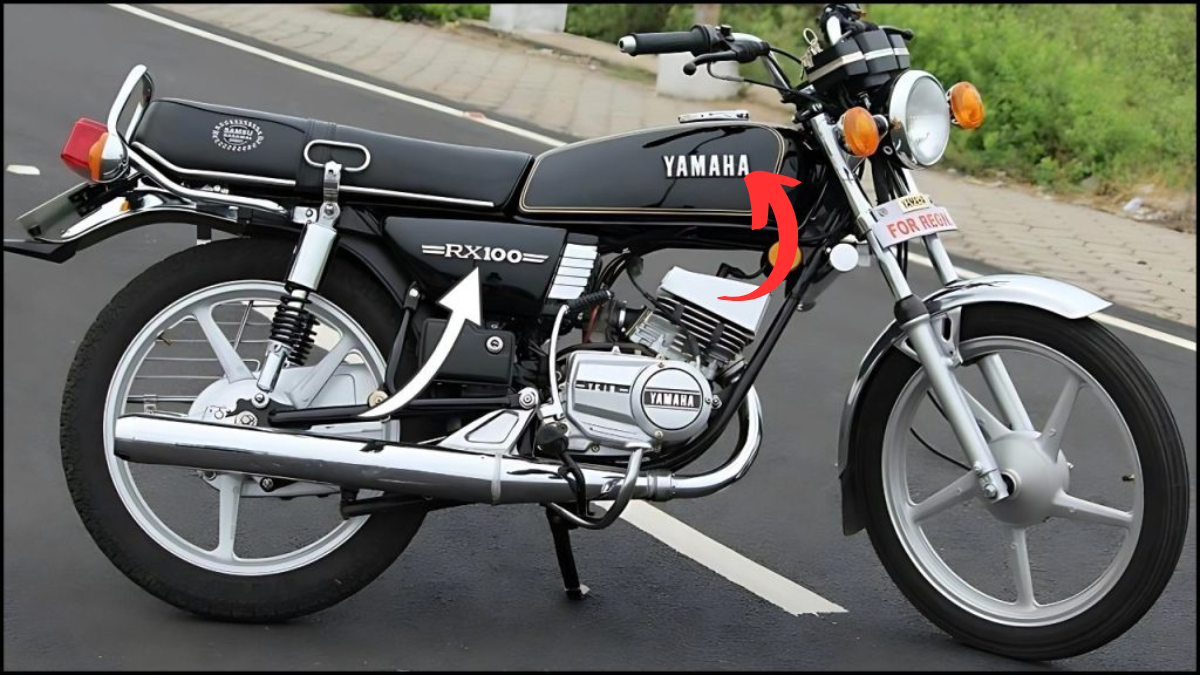Yamaha RX100:In the golden sunlight of a warm afternoon, a light blue haze lingers in the air while a shrill, high-pitched sound reverberates across the road. That sound is nearly extinct in today’s traffic-clogged, four-stroke-dominated world – but for those who grew up in India in the 1980s and ’90s, it’s instantly recognisable. That sound belongs to none other than the Yamaha RX100, a motorcycle that not only transported riders but also ignited a cultural movement.
Birth of a legend
When Yamaha launched the RX100 in partnership with Escorts Ltd in 1985, India’s motorcycle landscape was relatively plain. The roads were dominated by utilitarian commuter bikes, Royal Enfields were for those who could spend a little more. High-performance machines were few and far between, and the idea of an affordable motorcycle that could also deliver thrills was largely missing.
This changed overnight with the arrival of the Yamaha RX100.
The early models were imported as CKD (Completely Knocked Down) kits from Japan and assembled in India. These early bikes, with “Made in Japan” stamped on their gearbox casings and Rajdoot-branded Yenke speedometers, signalled the arrival of something extraordinary.
While the legendary Yamaha RD350 existed, it was too expensive and impractical for most Indians. The RX100, on the other hand, delivers great performance without breaking the bank. It strikes the perfect balance – affordable enough for the mid-range, yet powerful enough to excite any adrenaline lover.
“We didn’t just launch motorcycles; we introduced an entirely new riding culture,” recalls one Yamaha executive from that era.
Engineering ingenuity, unmatched performance
The Yamaha RX100’s specifications may seem modest by modern standards – a 98cc, two-stroke, air-cooled single-cylinder engine that produces 11 PS of power and 10.39 Nm of torque at 7,500 RPM. But that’s only half the story.
Due to its light weight, the RX100 could accelerate from 0 to 60 km/h in about 7 seconds, which was unprecedented for its time and engine class. The use of reed valve induction – rare in its class at the time – provided smooth power delivery and a crisp throttle response that became legendary.
A four-speed constant mesh gearbox perfectly complemented the engine, and the double-cradle chassis offered exceptional handling. Telescopic forks at the front and dual shock absorbers at the rear made the ride feel stable and confident in traffic or on open roads.
Add 18-inch spoked wheels, an ideal weight distribution and a responsive suspension, and you had a motorcycle that was not just fun – but lively as well.
Veteran mechanic Rahul Desai sums it up best:
“There wasn’t one feature that made the RX100 special. What made it special was its harmony – the engine, frame, suspension and weight all worked together like a symphony.”
A Cultural Phenomenon Beyond Performance
The Yamaha RX100 didn’t just win over riders with performance—it captured hearts and minds. Yamaha’s marketing machine positioned the RX100 as more than just a motorcycle—it was a lifestyle. Catchy taglines like “Born to Lead” and “Ahead of the 100” appealed to young, ambitious Indians.
TV ads showed the RX100 easily outpacing bigger bikes, and print ads paired the bike with fashion models, making it look both fast and stylish. It became a status symbol – owning one meant you weren’t just a regular commuter; you were a rider.
The motorcycle’s distinctive sound became an unofficial anthem of youth culture. Street races, weekend meetups and endless debates over which RX100 was faster further enhanced its legendary status.
“During college days, you either drove what your parents gave you – or you had an RX100. It made a lot of difference,” recalls longtime car owner Rajiv Menon.
From cities to villages: The universal appeal of the RX100
What made the Yamaha RX100 stand out was its accessibility. Urban youth loved its aggressive looks and great performance, but even in rural India, the RX100 became a symbol of freedom and pride.
Reliable and easy to maintain, it could ride rough roads as confidently as it could in city traffic. Its mechanical simplicity meant that even in areas with limited infrastructure, the bike could be serviced with minimal tools and parts.
For many, owning a Yamaha RX100 wasn’t just about owning a bike – it was a step toward modernity, freedom and upward mobility.
The Evolution of the RX Lineup
The Yamaha RX100 remained largely unchanged during its 11-year production run, which is a testament to how well it was designed from the start. The biggest change was a shift from a 6-volt to a 12-volt electrical system to support the more reliable CDI ignition.
When production ended in 1996, Yamaha continued the RX legacy with models like the RXG, RX-Z and RX135. Each added minor changes or stylistic updates, but none recaptured the purity of the original RX100. Emissions norms eventually forced Yamaha to detune these machines and add catalytic converters, which reduced their performance.
By 2005, the final RX135 rolled off the assembly line, bringing the RX era to an end.
Vintage bike collector Harpreet Singh sums it up when he says:
“Subsequent models had more power on paper, but they lacked the raw, honest soul of the RX100. It’s never really been replaced.”
Tuning and customisation scene
One of the reasons that kept the Yamaha RX100 alive in people’s memories was the vibrant modification culture that surrounded it. From performance tuning to aesthetic customisation, the RX100 acted like a blank canvas for creativity.
Yamaha RX100 performance mods often started with installing expansion chambers – bulbous exhaust systems that enhanced the two-stroke power delivery. Ported cylinders, high-compression pistons and tuned carburettors turned the RX100 into a true street weapon that could outrun even much bigger machines.
In Hyderabad, two-stroke tuning specialist Mohammed Ali explains:
“With the right setup, the RX100 could easily beat a 150cc or even a 200cc four-stroke. It was crazy.”
Visual modifications also flourished. Enthusiasts turned their RX100s into cafe racers, scramblers and even bobbers. The bike’s simple frame and design allowed for endless possibilities, giving rise to a thriving aftermarket ecosystem that is still active today.
The rise of the collector’s market
As stricter emissions laws made two-stroke bikes obsolete, demand for the Yamaha RX100 skyrocketed. What was once an inexpensive used bike can now cost over ₹1 lakh – or even more – if it is in original condition.
Yamaha RX100 vintage restorers spend months sourcing authentic parts, decals and paint codes to restore these machines to their former glory. Original exhausts, fuel tanks and speedometers have become prized possessions in the world of restoration.
Restorer Vikram Pratap observes:
“I’ve worked on classic British and Italian bikes worth millions, but none of them evoke the same emotional connection as the RX100. Everyone has a story about it.”
Online communities for RX100 enthusiasts are thriving. Social media groups, forums and restoration blogs offer tips, advice and camaraderie to collectors and riders trying to keep the legacy alive.
A Lasting Legacy in Indian Motorcycling
The Yamaha RX100 did more than set the benchmark for performance—it changed the way Indians thought about motorcycles. It created a generation of passionate riders who began to expect more from their machines—more performance, better handling and, above all, more fun.
Its impact forced competitors to up their game, sparking a shift towards sportier, better-performing bikes in the Indian two-wheeler industry. That cultural and technological momentum continues today, with modern bikes now offering high performance as a standard—not a luxury.
More importantly, the Yamaha RX100 turned casual riders into lifelong motorcycle enthusiasts. Its distinctive character, simple mechanics and unforgettable presence on the road ensured it wasn’t just another motorcycle—it was an emotion.
Conclusion
In the world of motorcycles, very few machines achieve the legendary status that the Yamaha RX100 enjoys. Whether it’s the intoxicating sound of its two-stroke engine, the thrill of its throttle response, or the memories it created for an entire generation, the RX100 stands out.
The Yamaha RX100 is more than just metal, rubber and gasoline – it was and is a movement. For many, the RX100 wasn’t just the start of a journey; it was the reason they started riding. And that’s a legacy no specification sheet can describe.





